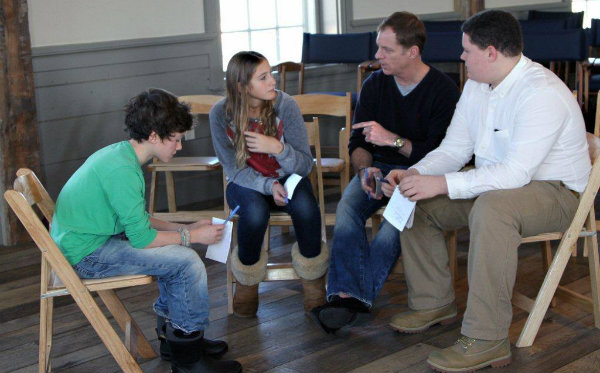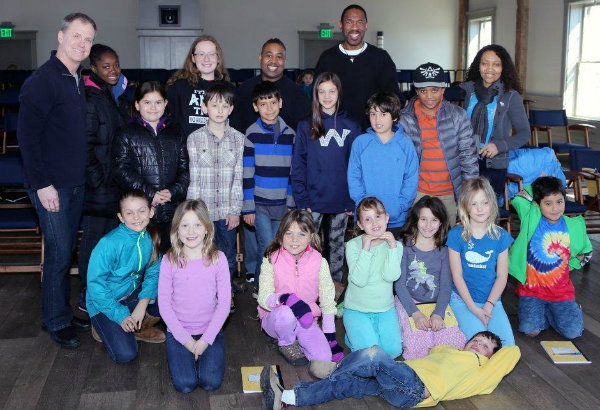How Laughter Can Lead to Better Learning
Kevin J. Flynn is a professional actor and stand up comedian who also works with students in the middle grades to help them develop their communication and speaking skills. What Kevin describes here could be a really fun, skill-building activity to end the year!
 By Kevin Flynn
By Kevin Flynn
“According to most studies, people’s number one fear is public speaking. Number two is death. Death is number two! This means, to the average person, if you go to a funeral, you’re better off in the casket than doing the eulogy.”
— Jerry Seinfeld
Jerry Seinfeld gets a big laugh with this bit, but for many, the fear of public speaking is no joke. Delivering a speech, a toast, or even a simple answer to a teacher’s question can produce a debilitating wave of anxiety.
But what if students could find a way to overcome their fear, learn storytelling and become more confident public speakers?
Teaching these skills to students in the middle grades, just as they are entering adolescence and experiencing the all-too-familiar self-consciousness that comes with it, can lay the groundwork for greater success even before they enter high school and also help them prepare for college and career.
Teaching Better Communication and Resilience
Employers are keen on hiring people who are able to communicate well, tell a story, and, as simple as it may seem, be comfortable making eye contact. Some even feel that learning good communication skills may be more important than math and history.
Warren Buffett recently spoke about the subject on CNBC, claiming that students should focus on learning how to write and speak clearly. “The one easy way to become worth 50 percent more than you are now — at least — is to hone your communication skills — both written and verbal,” says Buffett. He also points to a specific skill when he mentions, “Today, if you want to succeed as an entrepreneur, you also have to be a storyteller.”
Whether people are communicating with just one person or with a group, telling a story or a joke can help build rapport and prime the audience to hear the speaker’s message. These are some of the strategies students pick up when learning stand up comedy. Stand up is an effective and enjoyable way to learn the art of public speaking.
 One of the reasons it’s so effective is because it also teaches how to cope with failure. Just as most comedians fail repeatedly before eventually developing a winning routine, students suffer the same type of growing pains when learning to speak in front of groups. They need to learn that failure is an integral part of the learning process.
One of the reasons it’s so effective is because it also teaches how to cope with failure. Just as most comedians fail repeatedly before eventually developing a winning routine, students suffer the same type of growing pains when learning to speak in front of groups. They need to learn that failure is an integral part of the learning process.
In comedy, the clear expectation is that your first try is never your best. Reworking, revising, and rewriting are all part of the process. Students develop a growth mindset when they focus on improvement rather than the initial product, and resilience becomes the key to hard-earned, long-term success.
Getting started
 Teaching stand up to students starts with storytelling, an approach that works no matter what mix of personalities you may have in your middle school classroom.
Teaching stand up to students starts with storytelling, an approach that works no matter what mix of personalities you may have in your middle school classroom.
Often there are the extroverts, some who may be the “theater kids,” the observers or quieter kids, plus a range of personalities in between. Through it all, one thing remains true: no one wants to be the first to go up in front of the group. Whether or not teachers have had any experience with comedy, here are some steps to use to get started:
-
- To break the ice, share a humorous personal anecdote of your own with the class. Keep it short — no more than two or three minutes. (If you’re not comfortable telling one of your own stories, you can show them one of mine.)
- Then ask, “Who wants to tell my story but present it in a different way?”
- Give students an opportunity to volunteer to tell their own version of your story to the class or to a small group.
- After the first one gives it a go, tell that student, “You just did stand up comedy!” You will find he or she is both relieved and surprised.
Asking students to retell a funny story provides a model and takes the pressure off. It allows them to focus on getting comfortable speaking in front of others before adding to that the vulnerability that comes with sharing their own personal stories.
This isn’t true only of adolescents, but for all first-time speakers. Once the class sees that it’s achievable, others will jump in and soon the entire group will participate. This type of collaborative and encouraging experience inspires confidence across the board.
Honing technique
 Once the basis of a story is developed, students can work on hyperbole, physicality, and characterization. Kids are often so literal in their interpretations that it’s important to teach them to exaggerate and “punch it up.”
Once the basis of a story is developed, students can work on hyperbole, physicality, and characterization. Kids are often so literal in their interpretations that it’s important to teach them to exaggerate and “punch it up.”
For instance, if a student is telling a story and mentions that, in a particular situation, he walked in a funny way or even skipped, I teach him to play up that characteristic. It will get a laugh and loosen up the class. By adding heightened character themes, students learn the importance of the illustrative process and the ability to color in a basic storyline from beginning to middle to end.
Students can then work in teams and create what is equivalent to a “writer’s room” in the comedy world. They collaborate, interact and develop ideas through group brainstorming. This collective exercise asks students to turn on their creativity while learning the fundamentals of developing a narrative line and invites them to use their imagination and creativity.
Building community and confidence
There are other powerful benefits to teaching comedy to middle school students. At an age when students are often spending hours each day using social media or playing video games, many are trending toward technology-driven isolation. Even though they are connecting with friends over devices, these virtual connections lack the nuance and richness of in-person interaction.
 Comedy can provide more balance and give students ample opportunities to hone their social skills. Specifically, it helps sharpen their focus on those around them as they learn to adapt their routines based on give and take with their peers.
Comedy can provide more balance and give students ample opportunities to hone their social skills. Specifically, it helps sharpen their focus on those around them as they learn to adapt their routines based on give and take with their peers.
And the process of working in teams to develop and test out new material builds community in the classroom and creates a learning environment where students, alone and together, can explore self-expression in front of an audience.
By teaching public speaking through the lens of comedy, students not only learn how to overcome their fear of public speaking, but also how to communicate effectively, with humor and impact, and these are skills that will prime them for future success.
Indeed, the thrill of captivating an audience and eliciting laughs is often an indelible and transformative experience. Laughter does genuinely lead to better learning as students often become more engaged as a result and carry over their newfound enthusiasm into other disciplines.
Professional stand-up comedian Kevin Flynn is Co-Founder of Stand Up & Learn, a nonprofit comedy education program designed to empower young people to build self-confidence through learning to write and perform original stand-up comedy. Stand Up & Learn is part of the Nantucket Comedy Festival, which Kevin founded with Bonnie Block in 2007. To find out more information or to bring the Stand Up & Learn curriculum to your school, get in touch here. Connect with Kevin on Twitter @Kjfly or email him at kevinflynnlive@gmail.com.

Kevin Flynn and Ben Stiller in a scene from The Heartbreak Kid (2007).































